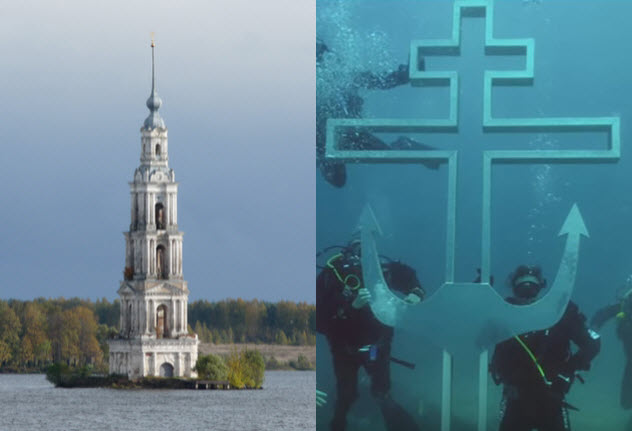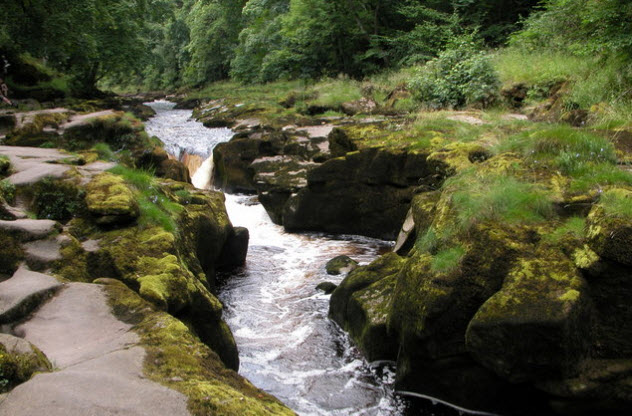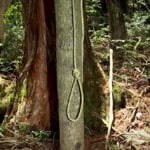 Weird Stuff
Weird Stuff  Weird Stuff
Weird Stuff  History
History 10 Legends Whose Last Moments Undid Their Glory
 Health
Health 10 Futuristic Ideas to Treat Common Medical Problems
 Weird Stuff
Weird Stuff Ten Surreal Attempts to Reverse Baldness
 Facts
Facts 10 U.S. Government Contingency Plans for the Unthinkable
 History
History 10 Weird Distractions from the Great Depression
 Movies and TV
Movies and TV 10 Fictional Kings Who Go from Good to Bad
 Food
Food The Fantastic Chemistry Behind Why 10 Popular Foods Taste So Good
 Technology
Technology 10 Futuristic Fungal Technologies
 History
History 10 Not-so-Spooky Events That Also Happened on October 31
 Weird Stuff
Weird Stuff 10 Things So Rare They’ve Only Been Found Once
 History
History 10 Legends Whose Last Moments Undid Their Glory
 Health
Health 10 Futuristic Ideas to Treat Common Medical Problems
Who's Behind Listverse?

Jamie Frater
Head Editor
Jamie founded Listverse due to an insatiable desire to share fascinating, obscure, and bizarre facts. He has been a guest speaker on numerous national radio and television stations and is a five time published author.
More About Us Weird Stuff
Weird Stuff Ten Surreal Attempts to Reverse Baldness
 Facts
Facts 10 U.S. Government Contingency Plans for the Unthinkable
 History
History 10 Weird Distractions from the Great Depression
 Movies and TV
Movies and TV 10 Fictional Kings Who Go from Good to Bad
 Food
Food The Fantastic Chemistry Behind Why 10 Popular Foods Taste So Good
 Technology
Technology 10 Futuristic Fungal Technologies
 History
History 10 Not-so-Spooky Events That Also Happened on October 31
10 Intriguing Stories About Real-Life Water Oddities
From deadly water hazards to strange escape islands to curious Easter eggs that can be unlocked with the code word “Listverse,” here are 10 intriguing stories about real-life water oddities.
10 Kick ‘Em Jenny
On August 5, 1944, the Island Queen, a wooden schooner, vanished in the beautiful blue waters of the Caribbean between St. Vincent and Grenada. All 60 people aboard were lost.
With World War II in full swing, many people assumed that the boat had been torpedoed by an Allied or German submarine. But there was absolutely no debris in the water, which didn’t make sense.
Scientists now believe that a natural underwater predator devoured the ship whole, somewhat like humpback whales use bubble nets. As we discussed earlier, five to eight humpbacks will swim beneath a school of herring and release columns of bubbles from their blowholes to encircle the frightened fish. Then the whales open their huge mouths and swallow their trapped prey.
The underwater volcano Kick ’em Jenny does much the same thing, only she works alone. The volcano got its cool name from local fishermen whose boats were whipped around in the rough waters like they were getting kicked by a “jenny” (mule).
Since it was discovered in 1939, Kick ’em Jenny has blown its top about once every 10 years. Although the risk is small, an eruption can trigger a localized tsunami or throw hot rocks into the air as far as 5 kilometers (3 mi) away, causing damage to or destruction of nearby ships.
But there’s a more subtle danger that occurs when the volcano is seething between eruptions. Like the humpback whales, Kick ’em Jenny can release large columns of bubbles into the water in a process called degassing.
As the bubbles rise, seawater is displaced. Boats that pass over this area of lower water density can lose buoyancy and sink in one piece toward the volcano’s gaping maw. That’s probably what happened to the doomed Island Queen.
9 Ganvie
In the 17th century, powerful Fon warriors in West Africa saved their people from slavery by striking a deal with the Portuguese. In exchange for their freedom, the Fon captured members of smaller, weaker tribes in the area and sold those people into slavery instead.
One day, a member of the Tofinu tribe came up with an ingenious idea to defeat the Fon without bloodshed. The Fon tribe believed that a demon lived in nearby Lake Nokoue. Their religious beliefs stopped them from attacking anyone who lived in the water.
So the Tofinu moved into the huge lagoon, building an entire village of huts on stilts. As long as they lived in the water, they were safe.
Over time, the lake settlement grew into the self-sustaining town of Ganvie. The town has approximately 30,000 inhabitants who still live in huts on stilts. They row canoes to visit each other, even their next-door neighbors.
Although there’s no longer a threat of slavery, the residents go to the church, bank, post office, market, and hospital on the lake. Visitors can even stay at a hotel there. The school is the only building situated entirely on an island. The residents are also importing soil for a cemetery.
Families are run like businesses. The men usually farm fish, which they sell to their wives. Then the women sell the fish at the market. Ultimately, the wives are responsible for keeping everyone fed and the money rolling in.
8 Witley Park
J. Whitaker Wright had the vulgar taste of a wealthy man who dreamed big and lived loud. Born into modest circumstances in England in 1845, Wright made his fortune in America as a young man. After losing everything, he returned to England and became rich again by enticing investors to buy into fraudulent mining companies.
For his personal use, Wright snapped up two estates that he combined into the 1,400-acre Witley Park in Surrey. He began construction of a 32-bedroom mansion with 11 baths, a palm court, a theater, a velodrome, a private hospital, and more. To the serious concern of his neighbors, he also resculpted the landscape, leveling hills and creating three artificial lakes and an artificial island.
But the man who so publicly flaunted his wealth kept his masterpiece hidden underwater, where it was visible by invitation only. To outsiders, the only clue was a Neptune statue that appeared to walk on water in the middle of a lake.
In reality, Neptune stood on a glass-and-metal dome. The underwater dome shielded visitors as they competed in billiards, enjoyed a dance, or simply gazed at the fish swimming in the lake around them.
Unfortunately for Wright and his investors, his billiards room wasn’t the only thing that was underwater. One of his companies failed, sparking a string of bankruptcies for related companies and his investors. In 1904, he was convicted of fraud and sentenced to seven years in prison.
But the slippery former mogul wasn’t about to get locked up. Meeting with his lawyers in the courthouse after the verdict, Wright requested a cigar and some whiskey. Then he swallowed a smuggled cyanide capsule and died in the same dramatic, middle-finger fashion in which he had lived.
7 The Walkable World Map
If you’re ever in Denmark and you want to take a quick walk around the world, Soren Poulsen has got you covered. You can even paddle a small rowboat across the Pacific Ocean to play a game of miniature golf or to grab a pastry and coffee.
At his family farm on Lake Klejtrup, Poulsen spent the last 25 years of his life constructing Verdenskortet (“Map of the World”) with little more than a wheelbarrow and some hand tools.
From 1944 until his death at age 81 in 1969, he worked entirely by hand to build a 4,000-square-meter (43,000 ft2) miniature map of the world to scale. Every 27 meters (89 ft) of his outdoor map corresponds to 111 kilometers (69 mi) of the Earth’s actual surface.
In the wintertime, Poulsen would place dozens of boulders and smaller stones on the frozen lake to position the landmasses for his map. As warmer weather thawed the lake, the boulders and stones would sink into the water to form the base of the landmasses.
Then Poulsen would complete each section with more stones, soil, and grass. Each country has a replica of its flag planted in the appropriate spot on the map.
Poulsen was born on this property in 1888. Although he spent 20 years in the US when he was young, he eventually returned to his family farm to start an orchard business. When that venture failed, he indulged his interest in geography and began building a walkable world map.
Today, Verdenskortet is a thriving tourist attraction with many family-oriented activities.
6 Gruner See
Like a caterpillar emerging from its cocoon as a beautiful butterfly, Gruner See (“Green Lake”) in Styria, Austria, undergoes a metamorphosis each year, transforming from a winter pond nestled in a scenic park at the base of the Hochschwab Mountains into a crystal clear emerald lake with a magical world beneath.
For centuries, this has happened each year around the beginning of May as melted snow flows down the mountains to flood the basin of land below. The lake is about 1–2 meters (3–6 ft) deep in the winter but swells to a maximum depth of about 12 meters (40 ft) in the late spring and early summer.
If adventurous summertime visitors bring scuba gear, they can glide through shimmering, ice-cold water so clear that it’s like peering through polished glass at an enchanting storybook world.
The underwater benches and footbridges, the hiking trails and submerged trees, and the swaying green grasses at the bottom of the lake, which give the water its emerald-green color, seem to be frozen in time. Only the occasional trout swimming by appears to be living in the here and now.
As professional photographer and scuba diver Thomas Aichinger told Smithsonian magazine in an interview, “When you’re diving, you feel like you’re flying since you’re swimming above the park’s submerged benches and bridges.”
But this yearly phenomenon doesn’t last long. By July, the water level drops quickly until this wondrous lake with its underwater Atlantis is no more than a magical memory.
5 St. Nicholas Cathedral

Russia has a history of putting religion underwater. Literally.
To modernize the Soviet Union in the 1930s, Joseph Stalin ordered the construction of reservoirs and dams on the Upper Volga that buried centuries of the region’s history in watery graves.
One of those graves, St. Nicholas Cathedral, has a headstone soaring 75 meters (245 ft) above the water of the Uglich Reservoir. Built around 1800, the headstone is actually the bell tower of the cathedral, which was built on the site of a 14th-century monastery in the Russian town of Kalyazin.
At one time, the once-famous monastery owned 200 settlements and 13 villages—all of which provided it with substantial income. The monastery even hosted VIPs such as Catherine the Great and Tsar Alexei Mikhailovich.
Although the monastery and surrounding buildings were eventually flooded, the bell tower was left standing for navigational purposes. For a while, boats could even sail into the lower part of the belfry.
Then an island was built around the structure. The Soviets trained paratroopers there until one got hurt jumping from the tower with an open parachute. Today, the bell tower is a tourist attraction and the site of occasional Orthodox Christian religious ceremonies.
In the 21st century, Russia is literally putting religion underwater again. In 2015, the Russian Orthodox church and the Night Wolves, a motorcycle gang linked to the Kremlin, began construction of the world’s first underwater church off the coast of Crimea.
So far, they’ve anchored a 3-ton cross to the bottom of the sea. This church will also be named after St. Nicholas, the patron saint of sailors. The site will double as an underwater museum of Crimean history.
4 Kelimutu’s Tricolored Lakes
Kelimutu National Park in Indonesia has the world’s only tricolored lakes, which are located at the summit of the Mount Kelimutu volcano. Like a 1970s mood ring, the three crater lakes change their spectacular colors frequently to reflect the moods of the spirits that live there. At least, that’s what the local villagers believe.
The striking colors are so thick that they look like paint on an artist’s palette. Although the lakes are physically close to each other, their colors change independently from one another—ranging from turquoise to a rusty red, green, brown, black, or even white.
No one is quite sure what’s going on. But scientists believe that volcanic gases mix with minerals in the water to trigger chemical reactions that produce the beautiful colors. The locals aren’t buying that scientific nonsense, though. For centuries, they’ve believed that the spirits of their dead ancestors rest in the lakes.
Off to itself, the westernmost lake is called Tiwu Ata Mbupu (“The Lake of Old People”). This is the resting place of old people who have led virtuous lives.
The middle lake is named Tiwu Nuwa Muri Koo Fai (“The Lake of Young Men and Maidens”) and is home to the souls of righteous young people.
Sharing a crater wall with the middle lake is Tiwu Ata Polo (“The Lake of Evil Spirits” or “The Enchanted Lake”). This lake traps the spirits of wicked people of any age after they die.
3 The Bolton Strid

Near Bolton Abbey in Yorkshire, England, there’s a booby trap that swallows unsuspecting visitors. At about 2 meters (6 ft) across, the Bolton Strid appears to be a knee-deep, mountain stream. It’s not. It’s a deceptively deep raging river. The exact depth is still a mystery, but the Strid’s ability to kill is not.
Despite the posted warnings, visitors occasionally try to jump the stream or cross it using stones that lie in the water. No one who has fallen in has lived to tell the tale. In most cases, their bodies were never recovered.
If any of these people had walked about 90 meters (300 ft) on, they would have realized that this mountain stream is actually a narrow stretch of the River Wharfe, which is usually about 9 meters (30 ft) across.
Although the banks of the Strid appear to be close to each other, the land on either side of the water is more like an overhang. Underneath, the powerful rushing currents have carved a maze of unseen tunnels and caves that may hold the remains of some of the Strid’s victims.
In one legend, a young boy named William de Romilly tried to jump the Strid in 1154. But he was unsuccessful and met a certain death when his body hit the water. Overcome with grief, his mother, Lady Alice de Romilly, gave the land around the Strid to monks, who then founded Bolton Abbey. William Wordsworth even wrote about de Romilly’s fate in his poem “The Force of Prayer.”
2 Big Major Cay
In the Bahamas, the spectacular island paradise of Big Major Cay is home to powdery white beaches, clear turquoise water, and about 20 wild pigs. That’s why it’s been nicknamed “Pig Island” or “Pig Beach.” Humans don’t live on the tiny island, but the locals and tourists sail in frequently to bring food to these wild creatures.
The pigs are fairly lazy but clever. Like the Tom Sawyers of the pig world, they get the humans to do most of the work. The pigs usually spend their days playing in the sand or sunning themselves while waiting for their next shipment of food.
When a boat ventures into their waters, the pigs reward their human benefactors with a water show. They swim out to meet the boats, get the food, and then frolic in the water and pose for pictures until the humans go away and let the pigs return to baking on the beach.
But the waters around Big Major Cay weren’t always a literal bay of pigs. European explorers often dumped domesticated pigs, chickens, goats, cattle, and other animals on islands throughout the world so that sailors could return to eat them later. Sometimes, the sailors didn’t come back. It’s also possible that the pigs escaped from boats and made their way to shore.
By the 1600s, there were a number of islands in the Caribbean with pigs gone wild. Early hunters of wild pigs barbecued their pork on a frame called a boucan or buccan. The word “buccaneer” came to mean “pirate” because Caribbean pirates apparently enjoyed hunting wild pigs and eating barbecued pork, too.
1 Jindo Island
People who don’t believe in the parting of the Red Sea should take a trip to South Korea’s Jindo Island to see what Ambassador Pierre Landy once described as the “Korean version of Moses’s miracle.” It may not change their opinions about the Red Sea, but it would still be exciting to take part in the annual Jindo Sea Parting Festival.
The Jindo Sea actually parts a few times each year between March and June. At that time, the sea level drops far enough to reveal a land bridge that is 40–60 meters (130–200 ft) wide.
Some scientists think that tidal harmonics cause the parting. According to this theory, gravitational forces align periodically to create an extremely low tide that reveals a land bridge.
During the four days of the annual festival, hundreds of thousands of people use the path to cross the 3 kilometers (2 mi) from Jindo Island to Modo Island. It’s not hard to imagine persecuted people escaping across the bridge before the sea closed again to prevent their enemies from following.
Jindo Island actually has an escape legend that stars an old woman and some tigers. According to the story, the island was overrun with tigers that frightened the villagers into leaving for Modo Island. But they accidentally forgot to take Grandma Bbyong with them.
Each day, poor grandma prayed to Yongwang, the ocean god, to reunite her with her family. Finally, she was told in a dream that a rainbow would allow her family to walk safely across the sea to get her the next day. As predicted, the Jindo Sea parted, the rainbow road miraculously came into view, and Bbyong’s family rescued her from the tiger-filled island.








